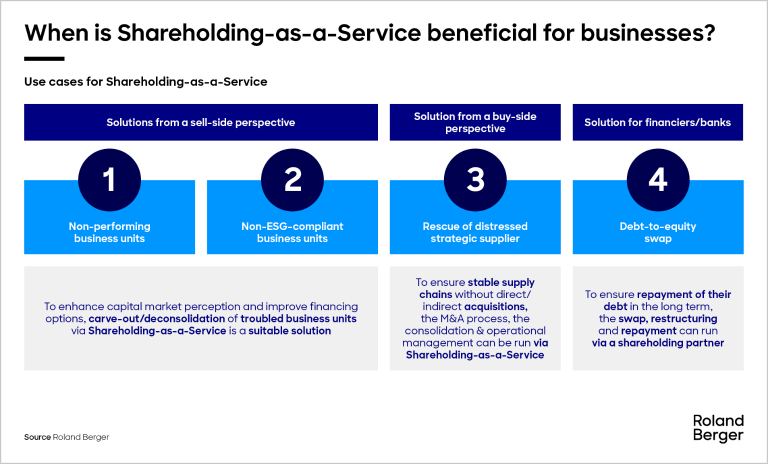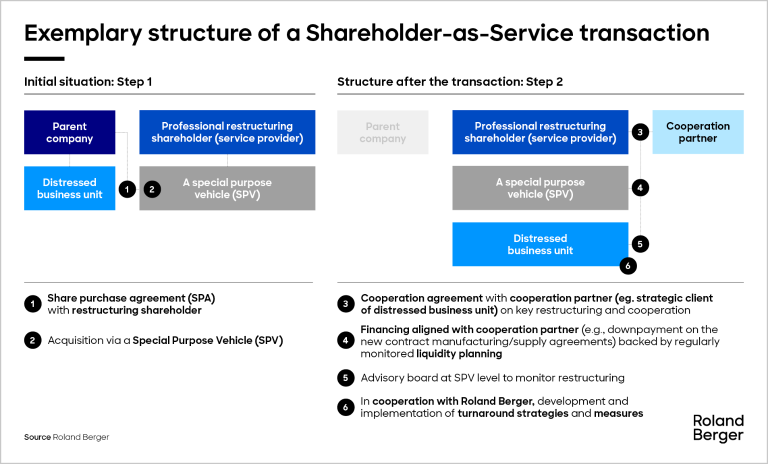Companies face challenges as a result of transformation and crises. Our comprehensive restructuring advice helps you to find convincing solutions, identify trends at an early stage and successfully realign yourself to remain competitive.

Shareholding-as-a-Service
By Marcus Wolf and Tom Hartmann
A secured framework for carving out non-core business units for restructuring, liquidation or M&A purposes.
Shareholding-as-a-Service is a carve-out model that allows companies to separate their core business from their non-core assets in order to restructure, liquidate or sell these non-core assets outside of their core business. This is achieved by transferring the non-core assets to a "restructuring shareholder" or a trustee, which facilitates their short-term deconsolidation, reducing liabilities and risks associated with the core business, while maintaining control via a restructuring agreement. Likewise, Shareholding-as-a-Service can be used as an investment vehicle to acquire businesses.

When is Shareholding-as-a-Service beneficial for businesses?
Shareholding-as-a-Service secures the operational continuation of the business unit while mitigating management risks and retaining restructuring opportunities, providing an attractive, customizable and efficient solution in several use cases.

"With Shareholding-as-a-Service, companies can carve out and restructure underperforming units off-balance-sheet - Safeguarding core operations and capital market messaging."
From a sell-side perspective, a parent company can realize a carve-out via Shareholding-as-a-Service, e.g., when a certain business unit is not performing well or does not offer a strategic fit with the rest of the group. This usually complicates investor communications and refinancing options, which is why deconsolidation is helpful as a first step. In the second step, those non-core businesses can be restructured and/or sold.
From a buy-side perspective, acquisitions via Shareholding-as-a-Service offer an indirect and uncomplicated option. For example, small yet critical suppliers can be easily acquired by conglomerates without having to go through the traditional, full M&A process and without taking the supplier on the balance sheet.
Shareholding-as-a-Service also enables debt-to-equity swaps for banks, as it allows them to convert outstanding debts into equity without having to directly act as shareholders. The shareholding service provider takes over the shares and manages them, while the banks are immediately compensated by the provider.
In all use cases, the non-core businesses can be restructured or made fit for sale while being within a secured environment with reduced risk and exposure to the main business.
What can Roland Berger offer in terms of Shareholding-as-a-Service?
Roland Berger acts as a key intermediary between the client and the Shareholding-as-a-Service provider, ensuring a well-structured transaction and successful restructuring.

"The external shareholder allows for efficient restructuring outside the core business with a precisely defined goal and exit trigger. Roland Berger acts as a bridge and a neutral third party."
Before the transaction, Roland Berger conducts a detailed financial assessment, calculating the transaction budget and evaluating post-transaction financial and liability risks. Our services include developing a comprehensive turnaround concept and providing a financing confirmation to secure the transaction.
After the transaction, we assist in the strategic and operational turnaround management of the carved-out business unit. This includes implementing restructuring measures, monitoring progress and ensuring financial stability. If unexpected liquidity needs arise, we reassess financial requirements and support follow-up financing. Roland Berger can also provide experienced executives, such as CROs and CFOs, to drive the operational transformation. Additionally, we can assist with M&A and corporate finance services if needed.
By guiding the entire process, Roland Berger ensures that Shareholding-as-a-Service transactions are executed smoothly while securing the financial and operational stability of the carved-out business.
Register now to receive regular updates on our restructuring and turnaround topics and publications.



